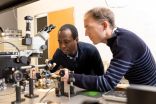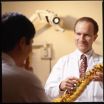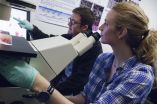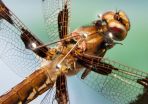(Press-News.org) Massachusetts General Hospital (MGH) investigators have identified two compounds that appear, in cellular and animal models, to block the cardiac damage caused by the important chemotherapy drug doxorubicin. Their report in the Dec. 10 issue of Science Translational Medicine indicates that inhibiting the action of an enzyme that is key to the generation of cellular energy in mitochondria could prevent doxorubicin-induced damage to cardiac cells without reducing the drug's anti-tumor effects.
"Doxorubicin-induced cardiomyopathy limits the amount of the drug a patient can receive - which limits the ability to treat cancer - and even low, safer doses can lead to heart failure in up to 8 percent of patients," explains Randall Peterson, PhD, of the MGH Cardiovascular Research Center, senior author of the report. "Finding an effective cardioprotective drug - essentially separating the good and bad effects of this form of chemotherapy - could increase the beneficial effects of doxorubicin against cancer while reducing the rate of heart failure in treated patients."
The mechanism behind doxorubicin-induced cardiotoxicity remains unclear, and the only FDA-approved drug for its prevention may also reduce the anti-cancer effects, possibly leading to the development of secondary tumors. To conduct a broad search for potential protective compounds, the research team developed a zebrafish model of doxorubicin-induced heart failure against which they screened 3,000 molecules from two chemical libraries for the ability to prevent the kind of cardiac damage caused by the drug.
Eight of the tested chemicals reduced damage to the hearts of zebrafish embryos, and two compounds - visnagin and diphenylurea - were most potent in preventing both structural and functional damage. Further experiments in cells from mice and rats and in living zebrafish and mice that had been treated with doxorubicin found that either compound almost completely prevented the death of cardiac cells caused by the chemotherapy drug. In mouse models of both high- and low-dose doxorubicin treatment, visnagin - a natural compound synthesized by the toothpick weed - was able to maintain cardiac function.
Investigation of the possible mechanism behind visnagin's protective ability found that the compound binds to and inhibits the action of MDH2, an enzyme essential to the generation of cellular energy by mitochondria. Other agents that block MDH2 activity also protected zebrafish against doxorubicin-induced cardiac damage, and tests in both cellular and animal models of several types of cancer found that neither visnagin nor diphenylurea reduced the anti-tumor action of doxorubicin.
"We are still trying to determine exactly how inhibition of MDH2 protects the heart, but one intriguing idea is that doxorubicin may kill cardiac and tumor cells in different ways," explains Peterson. "Given the intense energy requirements of the beating heart, we speculate that cardiac cells may be especially susceptible to metabolic disturbance caused by doxorubicin and that inhibiting MDH2 may correct the metabolic imbalance and prevent the cells from dying.
"It remains to be seen if visnagin's protective effects are restricted to doxorubicin or if it can protect the heart from other kinds of damage," he adds. "We are pursuing this question by testing its ability to protect heart muscle from oxygen deprivation during heart attacks and from the effects of other heart-damaging chemotherapy drugs." Peterson is the Charles Addison and Elizabeth Ann Sanders Associate Professor of Basic Sciences at Harvard Medical School.
INFORMATION:
The co-lead authors of the Science Translational Medicine report are Yan Liu, PhD, and Aarti Asnani, MD, of the MGH Cardiovascular Research Center. Additional co-authors are You Wang, PhD, Kumar Sarkar, Matthew Dai, Howard Chen, PhD, David Sosnovik, MD, and Jordan Shin, MD, PhD, MGH Cardiovascular Research Center; Min Yu, MD, PhD, and Daniel Haber, MD, PhD, MGH Cancer Center; Lin Zou, PhD, and Wei Chao, MD, PhD, MGH Anesthesia; and Victoria Bentley, MSc, Graham Dellaire, PhD, and Jason Berman, MD, Dalhousie University, Nova Scotia. Support for the study includes American Heart Association grant IRG14600006. Patent applications covering the cardioprotective compounds described in this paper have been filed.
Massachusetts General Hospital, founded in 1811, is the original and largest teaching hospital of Harvard Medical School. The MGH conducts the largest hospital-based research program in the United States, with an annual research budget of more than $785 million and major research centers in AIDS, cardiovascular research, cancer, computational and integrative biology, cutaneous biology, human genetics, medical imaging, neurodegenerative disorders, regenerative medicine, reproductive biology, systems biology, transplantation biology and photomedicine.
Treating the potentially blinding haze of a scar on the cornea might be as straightforward as growing stem cells from a tiny biopsy of the patient's undamaged eye and then placing them on the injury site, according to mouse model experiments conducted by researchers at the University of Pittsburgh School of Medicine. The findings, published today in Science Translational Medicine, could one day rescue vision for millions of people worldwide and decrease the need for corneal transplants.
According to the National Eye Institute, part of the National Institutes of Heath, ...
Rats that received thyroid hormones had a reduced risk for dangerous heart arrhythmias following a heart attack, according to a new study by a team of medical researchers at New York Institute of Technology.
In the NIH-funded study, published in the Journal of Cardiac Failure, the team found that thyroid hormone replacement therapy significantly reduced the incidence of atrial fibrillation - a specific kind of irregular heartbeat, or arrhythmia -- in the rats, compared to a control group that did not receive the hormones.
The finding could have important implications ...
San Diego, Calif., Dec. 10, 2014 -- Engineers at the University of California, San Diego have demonstrated a new and more efficient way to trap light, using a phenomenon called bound states in the continuum (BIC) that was first proposed in the early days of quantum wave mechanics.
Boubacar Kanté, an assistant professor in electrical and computer engineering at UC San Diego Jacobs School of Engineering, and his postdoctoral researcher Thomas Lepetit described their BIC experiment online in the rapid communication section of journal Physical Review B. The study directly ...
Researchers from North Carolina State University and Qatar University have developed a new "high-entropy" metal alloy that has a higher strength-to-weight ratio than any other existing metal material.
High-entropy alloys are materials that consist of five or more metals in approximately equal amounts. These alloys are currently the focus of significant attention in materials science and engineering because they can have desirable properties.
The NC State research team combined lithium, magnesium, titanium, aluminum and scandium to make a nanocrystalline high-entropy ...
Is it the thought that really counts?
When it comes to giving gift cards, maybe not.
New research from the University of Cincinnati can help even the most thoughtful gift giver avoid the mistake of over-personalization and keep that card from being banished to the bottom of a purse or hidden deep inside a wallet for the next six months.
"Givers often fail to anticipate that the gifts they prefer to give are not necessarily the ones recipients prefer to receive," says Mary Steffel, researcher and assistant professor of marketing in UC's Carl H. Lindner College of Business.
So ...
CORVALLIS, Ore. - Researchers for the first time have developed a method to track through the human body the movement of polycyclic aromatic hydrocarbons, or PAHs, as extraordinarily tiny amounts of these potential carcinogens are biologically processed and eliminated.
PAHs, which are the product of the incomplete combustion of carbon, have been a part of everyday human life since cave dwellers first roasted meat on an open fire. More sophisticated forms of exposure now range from smoked cheese to automobile air pollution, cigarettes, a ham sandwich and public drinking ...
Many children who sustain so-called open bone fractures in the forearm or lower leg can, and do, heal safely without surgery, according to the results of a small study led by investigators at the Johns Hopkins Children's Center.
Open fractures occur when the broken bone protrudes through the skin, causing a puncture wound.
The study, published ahead of print in the Journal of Children's Orthopaedics, shows that when the wound is small -- less ½-inch in diameter -- and the surrounding tissue is free of visible contamination with dirt or debris, children heal well ...
CAMBRIDGE, MA, December 10, 2014 - A team of investigators from the Broad Institute, Massachusetts General Hospital and other leading biomedical research institutions has pinpointed rare mutations in a gene called APOA5 that increase a person's risk of having a heart attack early in life. These mutations disable the APOA5 gene and also raise the levels in the blood of triglyceride-rich lipoproteins, a type of fat. The researchers' findings, together with other recent genetic discoveries -- specifically, the identification of protective mutations in the APOC3 gene that lower ...
Stem cells in early embryos have unlimited potential; they can become any type of cell, and researchers hope to one day harness this rejuvenating power to heal disease and injury. To do so, they must, among other things, figure out how to reliably arrest stem cells in a Peter Pan-like state of indefinite youth and potential. It's clear the right environment can help accomplish this, acting as a sort of Neverland for stem cells. Only now are scientists beginning to understand how.
New collaborative research between scientists at Rockefeller University and Memorial ...
The dragonfly is a swift and efficient hunter. Once it spots its prey, it takes about half a second to swoop beneath an unsuspecting insect and snatch it from the air. Scientists at the Howard Hughes Medical Institute's Janelia Research Campus have used motion-capture techniques to track the details of that chase, and found that a dragonfly's movement is guided by internal models of its own body and the anticipated movement of its prey. Similar internal models are used to guide behavior in humans.
"This highlights the role that internal models play in letting these creatures ...





